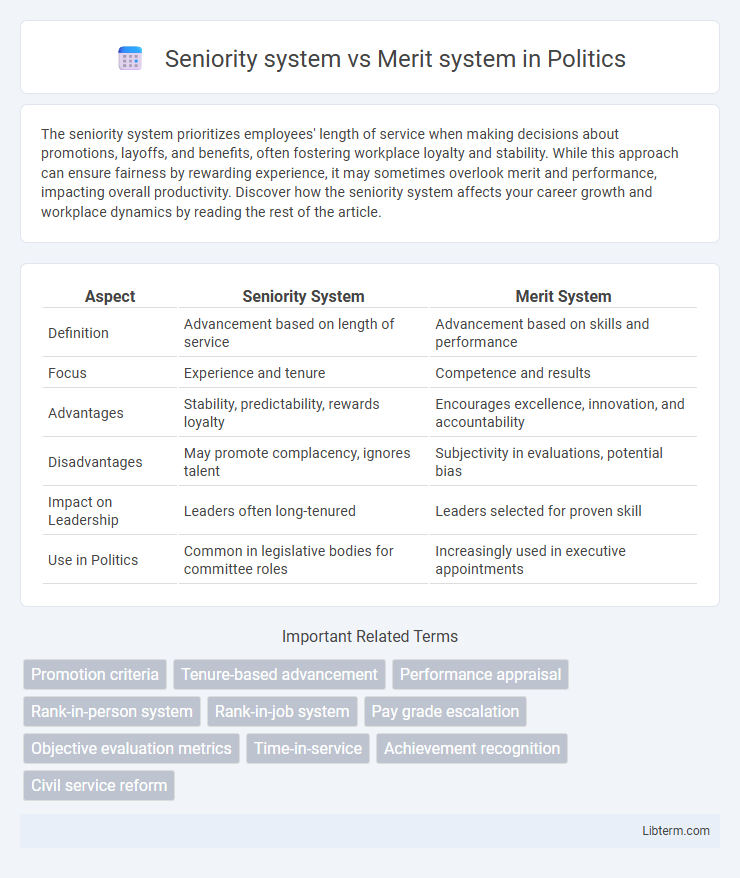The seniority system prioritizes employees' length of service when making decisions about promotions, layoffs, and benefits, often fostering workplace loyalty and stability. While this approach can ensure fairness by rewarding experience, it may sometimes overlook merit and performance, impacting overall productivity. Discover how the seniority system affects your career growth and workplace dynamics by reading the rest of the article.
Table of Comparison
| Aspect | Seniority System | Merit System |
|---|---|---|
| Definition | Advancement based on length of service | Advancement based on skills and performance |
| Focus | Experience and tenure | Competence and results |
| Advantages | Stability, predictability, rewards loyalty | Encourages excellence, innovation, and accountability |
| Disadvantages | May promote complacency, ignores talent | Subjectivity in evaluations, potential bias |
| Impact on Leadership | Leaders often long-tenured | Leaders selected for proven skill |
| Use in Politics | Common in legislative bodies for committee roles | Increasingly used in executive appointments |
Introduction to Seniority and Merit Systems
Seniority system bases employee rewards and promotions primarily on the length of service within an organization, ensuring predictable career progression and job security. Merit system evaluates employees based on performance, skills, and achievements, promoting talent and productivity-driven growth. Organizations often balance both systems to align experience with individual contributions effectively.
Defining the Seniority System
The seniority system is an organizational framework where employees' rights, benefits, and promotions are primarily determined by their length of service. This method emphasizes tenure as a key factor for career advancement, often valuing experience and loyalty over performance metrics. The seniority system contrasts with merit-based approaches by prioritizing stability and fairness linked to duration of employment rather than individual achievements.
Understanding the Merit System
The Merit System evaluates employees based on performance, skills, and contributions rather than tenure, promoting efficiency and incentivizing excellence. It leverages objective criteria such as achievements, competencies, and professional development to drive organizational success and employee growth. This system aims to enhance motivation and productivity by rewarding merit and aligning rewards with individual capabilities and results.
Key Differences Between Seniority and Merit Systems
The seniority system bases employee promotion and benefits on the length of service, prioritizing tenure over individual performance, whereas the merit system evaluates employees through skills, achievements, and productivity. Seniority systems often promote job security and predictability, while merit systems drive motivation by rewarding high performance and competence. Key differences include criteria for advancement, potential impact on workforce morale, and alignment with organizational goals focused on either experience or results.
Advantages of the Seniority System
The seniority system offers stability by rewarding employees with job security, predictable promotions, and benefits based on their tenure, fostering loyalty and long-term commitment within organizations. It reduces conflicts over subjective evaluations and ensures fairness through clear, objective criteria tied to length of service. This system simplifies administrative processes and motivates employees to remain with the company, enhancing institutional knowledge retention.
Benefits of the Merit System
The merit system enhances organizational efficiency by promoting employees based on skills, performance, and qualifications, ensuring the most capable individuals fill key positions. This approach fosters a culture of motivation and continuous improvement as employees are rewarded for their achievements rather than tenure. Companies adopting merit-based promotions often experience higher productivity, innovation, and job satisfaction compared to seniority-based systems.
Common Challenges in Implementation
The seniority system often faces challenges such as resistance to change and perceived unfairness by high-performing employees who feel advancement is based on tenure rather than skills. Conversely, the merit system struggles with subjectivity in performance evaluations and potential biases, complicating transparent and consistent implementation. Both systems require robust frameworks and clear criteria to balance fairness, motivation, and organizational goals effectively.
Impact on Employee Motivation and Performance
The seniority system, which rewards employees based on tenure, can lead to decreased motivation and performance as it may not recognize individual achievements or skills, potentially causing high performers to feel undervalued. In contrast, the merit system ties rewards and promotions directly to performance and accomplishments, fostering a culture of continuous improvement and driving employees to enhance their productivity. Organizations that implement merit-based systems often experience higher employee engagement, innovation, and overall organizational effectiveness.
Industry Applications: Where Each System Works Best
The seniority system thrives in industries with stable job roles and collective bargaining agreements, such as manufacturing and public sector employment, where experience and tenure drive promotions and job security. The merit system excels in dynamic fields like technology and finance, where performance, skills, and innovation directly influence advancement and reward. Balancing both systems can optimize workforce motivation and organizational goals depending on industry-specific needs.
Choosing the Right System for Your Organization
Choosing the right system between seniority and merit depends on your organization's goals and culture. The seniority system rewards employee loyalty and experience, promoting stability and reducing turnover, while the merit system incentivizes performance and skill development, driving innovation and productivity. Assessing factors like workforce diversity, industry demands, and long-term strategic objectives will help determine the most effective approach to employee advancement and retention.
Seniority system Infographic

 libterm.com
libterm.com